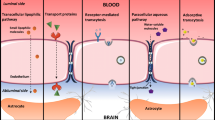Abstract
Gliomas are some of the most aggressive types of cancers but the blood–brain barrier acts as an obstacle to therapeutic intervention in brain-related diseases. The blood–brain barrier blocks the permeation of potentially toxic compounds into neural tissue through the interactions of brain endothelial cells with glial cells (astrocytes and pericytes) which induce the formation of tight junctions in endothelial cells lining the blood capillaries. In the present study, we characterize a glutathione-coated docetaxel-loaded PEG-PLGA nanoparticle, show its in vitro drug release data along with cytotoxicity data in C6 and RG2 cells, and investigate its trans-blood–brain barrier permeation through the establishment of a Transwell cellular co-culture. We show that the docetaxel-loaded nanoparticle’s size enables its trans-blood–brain barrier permeation; the nanoparticle exhibits a steady, sustained release of docetaxel; the drug is able to induce cell death in glioma models; and the glutathione-coated nanoparticle is able to permeate through the Transwell in vitro blood–brain barrier model.





Similar content being viewed by others
References
Yared JA, Tkaczuk KH. Update on taxane development: new analogs and new formulations. Drug Des Dev Ther. 2012;6:371.
Tije AJ, Verweij J, Loos WJ, Sparreboom A. Pharmacological effects of formulation vehicles: implications for cancer chemotherapy. Clin Pharmacokinet. 2003;42(7):665–85.
Sanson M, Napolitano M, Yaya R, Keime-Guibert F, Broët P, Hoang-Xuan K, et al. Second line chemotherapy with docetaxel in patients with recurrent malignant glioma: a phase II study. J Neuro-Oncol. 2000;50(3):245–9.
Kleihues P, Cavenee W. Pathology and genetics of tumours of the nervous system. International Agency for Research on Cancer (IARC) and WHO Health Organisation. Oxford: Oxford Press; 2000.
Lefranc F, Sauvage S, Van Goietsenoven G, Mégalizzi V, Lamoral-Theys D, Debeir O, et al. Narciclasine, a plant growth modulator, activates Rho and stress fibers in glioblastoma cells. Mol Cancer Ther. 2009;8(7):1739–50.
Lefranc F, Brotchi J, Kiss R. Possible future issues in the treatment of glioblastomas: special emphasis on cell migration and the resistance of migrating glioblastoma cells to apoptosis. J Clin Oncol. 2005;23(10):2411–22.
Grobben B, De Deyn P, Slegers H. Rat C6 glioma as experimental model system for the study of glioblastoma growth and invasion. Cell Tissue Res. 2002;310(3):257–70.
Kleihues P, Ohgaki H. Primary and secondary glioblastomas: from concept to clinical diagnosis. Neuro-Oncology. 1999;1(1):44–51.
Benda P, Lightbody J, Sato G, Levine L, Sweet W. Differentiated rat glial cell strain in tissue culture. Science. 1968;161(3839):370–1.
Geldenhuys W, Mbimba T, Bui T, Harrison K, Sutariya V. Brain-targeted delivery of paclitaxel using glutathione-coated nanoparticles for brain cancers. J Drug Target. 2011;19(9):837–45.
Carroll RT, Bhatia D, Geldenhuys W, Bhatia R, Miladore N, Bishayee A, et al. Brain-targeted delivery of Tempol-loaded nanoparticles for neurological disorders. J Drug Target. 2010;18(9):665–74.
Cecchelli R, Berezowski V, Lundquist S, Culot M, Renftel M, Dehouck M-P, et al. Modelling of the blood–brain barrier in drug discovery and development. Nat Rev Drug Discov. 2007;6(8):650–61.
Meyers JD, Doane T, Burda C, Basilion JP. Nanoparticles for imaging and treating brain cancer. Nanomedicine. 2013;8(1):123–43.
Kuhnline Sloan CD, Nandi P, Linz TH, Aldrich JV, Audus KL, Lunte SM. Analytical and biological methods for probing the blood–brain barrier. Annu Rev Anal Chem. 2012;5:505–31.
Valdovinos-Flores C, Gonsebatt ME. The role of amino acid transporters in GSH synthesis in the blood–brain barrier and central nervous system. Neurochem Int. 2012;61(3):405–14.
Limón-Pacheco JH, Hernández NA, Fanjul-Moles ML, Gonsebatt ME. Glutathione depletion activates mitogen-activated protein kinase (MAPK) pathways that display organ-specific responses and brain protection in mice. Free Radic Biol Med. 2007;43(9):1335–47.
Gaillard PJ. Glutathione-based drug delivery system. Google Patents; 2010.
Cecchelli R, Dehouck B, Descamps L, Fenart L, Buée-Scherrer V, Duhem C, et al. In vitro model for evaluating drug transport across the blood–brain barrier. Adv Drug Deliv Rev. 1999;36(2):165–78.
Hatherell K, Couraud P-O, Romero IA, Weksler B, Pilkington GJ. Development of a three-dimensional, all-human<i>in vitro</i>model of the blood–brain barrier using mono-, co-, and tri-cultivation Transwell models. J Neurosci Methods. 2011;199(2):223–9.
Gaillard PJ, Voorwinden LH, Nielsen JL, Ivanov A, Atsumi R, Engman H, et al. Establishment and functional characterization of an in vitro model of the blood–brain barrier, comprising a co-culture of brain capillary endothelial cells and astrocytes. Eur J Pharm Sci. 2001;12(3):215–22.
Garcia CM, Darland DC, Massingham LJ, D'Amore PA. Endothelial cell–astrocyte interactions and TGFβ are required for induction of blood–neural barrier properties. Dev Brain Res. 2004;152(1):25–38.
Sah H, Thoma LA, Desu HR, Sah E, Wood GC. Concepts and practices used to develop functional PLGA-based nanoparticulate systems. Int J Nanomedicine. 2013;8:747.
Danhier F, Ansorena E, Silva JM, Coco R, Le Breton A, Préat V. PLGA-based nanoparticles: an overview of biomedical applications. J Control Release. 2012;161(2):505–22.
Owens III DE, Peppas NA. Opsonization, biodistribution, and pharmacokinetics of polymeric nanoparticles. Int J Pharm. 2006;307(1):93–102.
Sabzevari A, Adibkia K, Hashemi H, Hedayatfar A, Mohsenzadeh N, Atyabi F, et al. Polymeric triamcinolone acetonide nanoparticles as a new alternative in the treatment of uveitis: In vitro and in vivo studies. Eur J Pharm Biopharm. 2013;84(1):63–71.
Etame AB, Smith CA, Chan WC, Rutka JT. Design and potential application of PEGylated gold nanoparticles with size-dependent permeation through brain microvasculature. Nanomedicine: NBM. 2011;7(6):992–1000.
Hatakeyama H, Akita H, Maruyama K, Suhara T, Harashima H. Factors governing the in vivo tissue uptake of transferrin-coupled polyethylene glycol liposomes in vivo. Int J Pharm. 2004;281(1):25–33.
Jinwal U, Groshev A, Zhang J, Grover A, Sutariya V. Preparation and Characterization of Methylene blue Nanoparticles for Alzheimer's disease and other Tauopathies. Curr Drug Deliv. 2013.
Wilhelm I, Fazakas C, Krizbai IA. In vitro models of the blood–brain barrier. Acta Neurobiol Exp (Wars). 2011;71(1):113–28.
Author information
Authors and Affiliations
Corresponding author
Additional information
Guest Editors: Mahavir B. Chougule and Chalet Tan
Rights and permissions
About this article
Cite this article
Grover, A., Hirani, A., Pathak, Y. et al. Brain-Targeted Delivery of Docetaxel by Glutathione-Coated Nanoparticles for Brain Cancer. AAPS PharmSciTech 15, 1562–1568 (2014). https://doi.org/10.1208/s12249-014-0165-0
Received:
Accepted:
Published:
Issue Date:
DOI: https://doi.org/10.1208/s12249-014-0165-0




